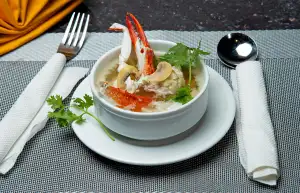Delicious and Nutritious Vegetarian Curry: A Flavorful Twist on Traditional Indian Cuisine

Vegetarian curry is a delectable and wholesome dish that has been enjoyed in Indian cuisine for centuries. Bursting with flavors and spices, this aromatic dish showcases the rich culinary heritage of India. Whether you follow a vegetarian lifestyle or simply want to explore new flavors, vegetarian curry offers a delicious and satisfying option. From creamy coconut curries to spicy lentil stews, there are countless variations to suit every palate. So, let's dive into the world of vegetarian curry and discover its enticing flavors and textures.
Health Benefits of Vegetarian Curry
Vegetarian curry not only tantalizes your taste buds but also offers numerous health benefits. Packed with an array of vegetables, legumes, and spices, this dish is a nutritional powerhouse. The combination of vegetables provides essential vitamins, minerals, and fiber that promote overall well-being. Additionally, the spices used in curry, such as turmeric and cumin, possess anti-inflammatory properties and may boost digestion. With its low-fat content and high nutrient density, vegetarian curry is a delicious way to support a healthy lifestyle.
Traditional Ingredients in Vegetarian Curry
Vegetarian curry is a delightful blend of spices and vegetables that have been used for centuries in Indian cuisine. The key to its rich and aromatic flavors lies in the traditional ingredients that are carefully selected and combined.
One of the main ingredients in vegetarian curry is a variety of fresh vegetables such as potatoes, cauliflower, peas, carrots, and bell peppers. These vegetables not only add texture and color to the dish but also provide essential nutrients like vitamins, minerals, and fiber.
Another important component of vegetarian curry is a medley of aromatic spices. Commonly used spices include cumin, coriander, turmeric, ginger, garlic, and chili powder. These spices not only enhance the taste but also offer numerous health benefits such as anti-inflammatory properties and aiding digestion.
To create a creamy base for the curry, many traditional recipes call for coconut milk or yogurt. Coconut milk adds a rich and velvety texture while yogurt lends a tangy flavor to the dish. Both these ingredients add depth to the overall taste profile of the curry.
Lastly, no vegetarian curry is complete without the addition of herbs like cilantro or mint leaves. These herbs add freshness and brightness to the dish while complementing the flavors of other ingredients.
By using these traditional ingredients in vegetarian curry, you can experience an explosion of flavors that will transport you to the vibrant streets of India.
Modern Twists on Vegetarian Curry
While traditional vegetarian curry recipes are undeniably delicious, there is always room for innovation and experimentation. Chefs around the world have been putting their own spin on this classic dish, incorporating modern ingredients and techniques to create exciting new flavors. Here are a few examples of modern twists on vegetarian curry:
1. Fusion Flavors: Many chefs are combining the flavors of different cuisines to create unique curry dishes. For instance, adding coconut milk and Thai spices to a traditional Indian curry can result in a delightful fusion of flavors.
2. Plant-Based Proteins: With the rise in popularity of plant-based diets, chefs are experimenting with alternative sources of protein in their curries. Ingredients like tofu, tempeh, and seitan can be used as meat substitutes, providing a hearty and nutritious addition to the dish.
3. Creative Use of Vegetables: Traditional curries often feature vegetables like potatoes, carrots, and peas. However, modern twists involve using a wider variety of vegetables such as kale, butternut squash, or even exotic mushrooms like shiitake or oyster mushrooms.
4. Lighter Sauces: While traditional curries tend to have rich and creamy sauces, modern variations often opt for lighter alternatives. Using coconut milk instead of heavy cream or incorporating yogurt can give the dish a refreshing twist without compromising on flavor.
These modern twists on vegetarian curry allow for endless possibilities when it comes to creating a flavorful and satisfying meal that appeals to both traditionalists and those looking for something new and exciting. By embracing these innovative approaches, we can continue to evolve the beloved tradition of vegetarian curry while keeping it relevant in today's culinary landscape.
Step-by-Step Recipe for Vegetarian Curry
1. Heat oil in a large pan over medium heat. Add onions and cook until they become translucent.
2. Add garlic, ginger, and spices like turmeric, cumin, coriander, and garam masala. Stir well to combine the flavors.
3. Add chopped vegetables such as carrots, bell peppers, and potatoes. Cook for a few minutes until they start to soften.
4. Pour in coconut milk or vegetable broth to create a creamy base for the curry.
5. Add diced tomatoes and simmer for about 15 minutes until the vegetables are tender.
6. Stir in cooked lentils or chickpeas for added protein and texture.
7. Season with salt and pepper to taste.
8. Garnish with fresh cilantro or mint leaves before serving.
9. Pair with steamed rice or naan bread for a complete meal.
This simple recipe allows you to create a flavorful vegetarian curry that is both satisfying and nutritious. Enjoy the rich blend of spices and vibrant vegetables in this delicious dish!
Serving Suggestions for Vegetarian Curry
When it comes to serving vegetarian curry, the possibilities are endless. This flavorful dish can be enjoyed on its own or paired with a variety of accompaniments to create a complete and satisfying meal. Here are some serving suggestions to enhance your vegetarian curry experience:
1. Rice: Serve your vegetarian curry over steamed basmati rice for a classic combination. The fragrant rice will absorb the flavors of the curry, creating a delicious and comforting meal.
2. Naan Bread: Pair your vegetarian curry with warm, freshly baked naan bread. The soft and fluffy bread is perfect for scooping up the curry and adds an extra layer of texture to each bite.
3. Roti: Another traditional Indian bread that complements vegetarian curry is roti. This thin and unleavened bread is great for wrapping around bites of curry, creating a handheld delight.
4. Raita: Cool down the spiciness of the curry with a side of raita. This refreshing yogurt-based dip is made with cucumber, mint, and spices, providing a creamy and cooling contrast to the bold flavors of the curry.
5. Pickles: Add some tanginess to your meal by serving pickles alongside your vegetarian curry. Mango pickle, lime pickle, or mixed vegetable pickle all bring a burst of flavor that pairs well with the rich and aromatic curry.
6. Salad: Balance out the richness of the curry with a fresh salad on the side. A simple mix of greens, tomatoes, cucumbers, and onions dressed in lemon juice or yogurt dressing can provide a refreshing contrast to the hearty flavors of the dish.
Remember, these are just suggestions – feel free to get creative and experiment with different combinations to find what suits your taste buds best!
Tips for Making the Perfect Vegetarian Curry
1. Use fresh ingredients: Opt for fresh vegetables and spices to enhance the flavors of your curry.
2. Toast your spices: Dry roast your whole spices like cumin, coriander, and cardamom before grinding them to release their aromatic oils.
3. Don't skimp on the onions: Cook your onions slowly until they are caramelized to add depth and sweetness to your curry.
4. Balance the flavors: Achieve a harmonious balance by adding a pinch of sugar or a squeeze of lemon juice to counteract any excessive bitterness or acidity.
5. Experiment with textures: Add a variety of vegetables with different textures, such as crunchy bell peppers or tender mushrooms, to create an interesting mouthfeel.
6. Simmer patiently: Allow your curry to simmer on low heat for a longer duration to allow the flavors to meld together and develop richness.
7. Adjust the spice level: Taste as you go along and adjust the amount of chili powder or other spices according to your preference for heat.
8. Garnish with herbs: Fresh cilantro or mint leaves sprinkled on top just before serving can add a burst of freshness and color to your dish.
By following these tips, you can create a vegetarian curry that is bursting with flavor and satisfies both traditional and modern palates alike.
In conclusion, vegetarian curry is not only a delicious and nutritious dish but also a flavorful twist on traditional Indian cuisine. It offers a wide range of health benefits, thanks to its rich blend of spices and vegetables. By incorporating modern twists into the traditional recipe, we can create unique and exciting variations of this classic dish.
With our step-by-step recipe, you can easily recreate the flavors of vegetarian curry in your own kitchen. Don't be afraid to experiment with different ingredients and spices to suit your taste preferences. Serve it with rice or naan bread for a complete meal that will satisfy your cravings.
To make the perfect vegetarian curry, remember to sauté the onions and spices until fragrant, allowing their flavors to develop fully. Adding coconut milk or yogurt will give it a creamy texture, while fresh herbs like cilantro or mint will add a burst of freshness.
So why not embrace the flavors of vegetarian curry and explore the endless possibilities it offers? Whether you're a seasoned cook or just starting out in the kitchen, this dish is sure to impress your family and friends. So go ahead, grab your apron, and let's dive into the world of vegetarian curry!
Published: 26. 11. 2023
Category: Food



